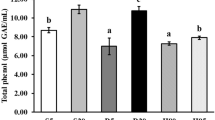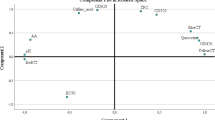Abstract
Less used date palm fruits, as Bouhattam variety, are being converted into coffee through a roasting thermal process. Therefore, laboratory assays were conducted to investigate chemical and cytotoxic proprieties of this commercial coffee. Mineral content determination showed that roasted seeds of Bouhattam were a source of K+ and Ca2+. Date seed powder was fractionated successively using organic solvents of increasing polarity (cyclohexane, CYHA; dichloromethane, DCM; and methanol, MeOH). While the best yield was recorded for CYHA fraction, the MeOH extract showed the strongest antioxidant activity associated with highest total polyphenol content (TPC) (56.7 mg eq GAE/g dry wt). LC-MS analysis revealed that two major phenolic compounds were identified in methanolic extract: protocatechic acid (67.6 mg/100 g dry wt), which is generally found in tea and quinic acid (39.5 mg/100 g dry wt), known as the main compound of coffee beans. Vitamin E was identified only in the MeOH extract and vitamin K1 was identified in DCM and CYHA ones. GC-MS data showed that the roasted date seed coffee was decaffeinated, and the most volatile compounds were identified as fatty acids in the CYHA extract. All tested organic extracts against MCF-7 and HCT-116 cell lines displayed lower cytotoxicity. Taken together, obtained results argued that roasted seed powder of Bouhattam variety is an excellent decaffeinated beverage enriched with polyphenols and vitamins concomitant with high antioxidant potential and lower cytotoxicity.

Graphical abstract





Similar content being viewed by others
Abbreviations
- ACN:
-
Acetonitrile
- CYHA:
-
Cyclohexane
- DCM:
-
Dichloromethane
- DMEM:
-
Dulbecco’s modified Eagle medium
- DMSO:
-
Dimethyl sulfoxide
- DPPH:
-
1-1-Diphenyl-2-picryl hydrazyl
- dry wt:
-
Dry weight
- GC-MS:
-
Gas chromatography-mass spectrometry
- HCT-116:
-
Human colon cancer
- LC-MS:
-
Liquid chromatography-mass spectrometry
- mAU:
-
Milli absorbance unit
- MeOH:
-
Methanol
- MCF-7:
-
Human breast cancer
- NIST:
-
National Institute of Standards and Technology
- RPMI:
-
Roswell Park Memorial Institute
- TPC:
-
Total phenolic content
References
El-Nemr A, Khaled A, Abdelwahab O, El-Sikaiy A (2007) Treatment of wastewater containing toxic chromium using new activated carbon developed from date palm seed. J Hazard Mater 152(1):263–275. https://doi.org/10.1016/j.jhazmat.2007.06.091
Metoui M, Essid A, Bouzoumita A, Ferchichi A (2018) Chemical composition, antioxidant, and antibacterial activity of Tunisian date palm seed. Pol J Environ Stud 28(1):1–8
Al-Houti SN, Sidhu JS, Alsaker JM, Al-Othman A (2002) Chemical composition and quality of date syrop as affected by pectinase/cellulose enzyme treatment. Food Chem 79:215–220. https://doi.org/10.1016/S0308-8146(02)00134-6
Besbes S, Claude D, Neila B, Georges L, Nour-Eddine D, Hamadi A (2004a) Date seeds: chemical composition and characteristic profiles of the lipid fraction. Food Chem 84:577–584. https://doi.org/10.1016/S0308-8146(03)00281-4
Fikry M, Yusof YA, Al-Awaadh AM, Rahman RA (2020) Prediction of the shelf-life of date seeds brew by integration of acceptability and quality indices. J Food Meas Charact 14(3):1158–1171. https://doi.org/10.1007/s11694-019-00365-4
Chiara N, Ferchichi A, Mrabet A, Sghairoun M (2007) Chemical composition of the flesh and the pits of date palm fruit and radical scavenging activity of their extracts. Pak J Biol Sci 10(13):2202–2207
Lecheb F, Benamara S, Gougam H (2011) Valorisation de l’huile du noyau de dattes. Editions Universitaires Européennes. France, pp 1-192
Bouaziz MA, Amara WB, Attia H, Blecker C, Besbes S (2010) Effect of the addition of defatted date seeds on wheat dough performance and bread quality. J Texture Stud 41:511–531. https://doi.org/10.1111/j.1745-4603.2010.00239.x
Fikry M, Yusof YA, Al-Awaadh AM, Rahman RA, Ghazali HM (2019) Antioxidative and quality properties of full-fat date seeds brew as influenced by the roasting conditions. Antioxidants 8:226. https://doi.org/10.3390/antiox8070226
Khali M, Boussena Z (2015) Effet de l’incorporation de noyaux de dattes sur les caractéristiques technologiques et fonctionnelles de la farine de blé tendre. Nat Tech 12:16–26
Al-Meqbaali F, Habib H, Othman A, Al-Marzooqi S (2017) The antioxidant activity of date seed: preliminary results of a preclinical in vivo study. Emir J Food Agr 29(11):822–832. https://doi.org/10.9755/ejfa.2017.v29.i11.1477
Lourenço SC, Mold M, Alves VD (2019) Antioxidants of natural plant origins: from sources to food industry applications. Molecules 24(22):14–16. https://doi.org/10.3390/molecules24224132
Negrão AF, Barreto LMRC, Orsi RO (2014) Size and chemical composition of bee pollen produced. J Apic Sci 58:7–12. https://doi.org/10.2478/jas-2014-0017
Zhong W, Ren T, Zhao L (2015) Determination of Pb (lead), Cd (cadmium), Cr (chromium), Cu (copper), and Ni (nickel) in Chinese tea with high-resolution continuum source graphite furnace atomic absorption spectrometry. J Food Drug Anal 24(1):46–55. https://doi.org/10.1016/j.jfda.2015.04.010
Bekir J, Mars M, Souchard JP, Bouajila J (2013) Assessment of antioxidant, antiinflammatory, anticholinesterase and cytotoxic activities of pomegranate (Punica granatum) leaves. Food Chem Toxicol 55:470–475. https://doi.org/10.1016/j.fct.2013.01.036
Kohoude MJ, Gbaguidi F, Agbani P, Ayedoun M, Cazaux S, Bouajila J (2017) Chemical composition and biological activities of extracts and essential oil of Boswellia dalzielii leaves. Pharm Biol 55(1):33–42 https://www.tandfonline.com/doi/full/10.1080/13880209.2016.1226356
Ayaz FA, Glew RH, Millson M, Huang HS, Chuang LT, Sanz C, Ayaz SH (2006) Nutrient contents of kale (Brassica oleraceae L. var. acephala DC.). Food Chem 96:572–579. https://doi.org/10.1016/j.foodchem.2005.03.011
Rahmani R, Jouaidi M, Bouajila J, Debouba M (2020) African mustard (Brassica tournefortii) as source of nutrients and nutraceuticals properties. J Food Sci 85(6):1856–1871
Ballesteros LF, Teixeira JA, Mussatto SI (2014) Chemical, functional, and structural properties of spent coffee grounds and coffee silver skin. Food Bioprocess Technol 7:3493–3503. https://doi.org/10.1007/s11947-014-1349-z
Adeosun AM, Oni SO, Ighodaro OM, Durosinlorun OH, Oyedele OM (2015) Phytochemical, minerals and free radical scavenging profiles of Phoenix dactylifera L. seed extract. J Taibah Univ Medical Sci 11:1–6. https://doi.org/10.1016/j.jtumed.2015.11.006
Bouaziz MA, Abbes F, Mokni A, Blecker C, Attia H, Besbes S (2017) The addition effect of Tunisian date seed fibers on the quality of chocolate spreads. J Texture Stud 48:143–150. https://doi.org/10.1111/jtxs.12225
Besbes S, Christophe B, Claude D, Neila B, Georges L, Nour-Eddine D, Hamadi A (2004b) Date seed oil phenolic, tocopherol and sterol profiles. J Food Lipids 11:251–265. https://doi.org/10.1111/j.1745-4522.2004.01141.x
Yen WJ, Wang BS, Chang LW, Duh DP (2005) Antioxidant properties of roasted coffee residues. J Agric Food Chem 53:2658–2663. https://doi.org/10.1021/jf0402429
Lecheb F (2010) Extraction physicochimique et biologiques de la matière grasse du noyau des dattes: Essai d’incorporation dans une crème cosmétique de soins. Mémoire de Thèse. Université de Boumerdes. Algérie, pp 1-179.
Sim YY, Ting W, Ong J, Nyam KL (2019) Effect of various solvents on the pulsed ultrasonic assisted extraction of phenolic compounds from Hibiscus cannabinus L. leaves. Ind Crop Prod 140:1–8. https://doi.org/10.1016/j.indcrop.2019.111708
Narita Y, Inouye K (2012) High antioxidant activity of coffee silver skin extracts obtained by the treatment of coffee silver skin with subcritical water. Food Chem 135(3):943–949. https://doi.org/10.1016/j.foodchem.2012.05.078
Lelyana R, Cahyono B (2015) Total phenolic acid contents in some commercial brands of coffee from Indonesia. J Med Plant Herbal Ther Res 3:27–29
Prasad KN, Yang E, Yi C, Zhao M, Jiang Y (2009) Effects of high pressure extraction on the extraction yield, total phenolic content and antioxidant activity of longan fruit pericarp. Innov Food Sci Emerg Technol 10(2):155–159. https://doi.org/10.1016/j.ifset.2008.11.007
Garcia-Salas P, Mar A, Segura-Carretero A, Fern A (2015) Identification and quantification of phenolic and other polar compounds in the edible part of Annona cherimola and its by-products by HPLC-DAD-ESI-QTOF-MS. Food Res Int 78:246–257. https://doi.org/10.1016/j.foodres.2015.10.002
Ioannone F, Di-Mattia CD, De-Gregorio M, Sergi M, Serafini M, Sacchetti G (2015) Flavanols, proanthocyanidins and antioxidant activity changes during cocoa (Theobroma cacao L.) roasting as affected by temperature and time of processing. Food Chem 174:256–262. https://doi.org/10.1016/j.foodchem.2014.11.019
Pinta MN, Montoliu I, Aura A, Sepp T, Barron D, Moco S (2018) In vitro gut metabolism of [U-13 C]-quinic acid, the other hydrolysis product of chlorogenic acid. Mol Nutr Food Res 62:1–7
Sen CK, Khanna S, Roy S (2006) Tocotrienols: vitamin E beyond tocopherols. Life Sci 78:2088–2098. https://doi.org/10.1016/j.lfs.2005.12.001
Siguret V (2006) Vitamin K: metabolism, physiopathology, implication in the inter- and intra-individual variability in the response to the vitamin K antagonists. Hematology 12(6):389–399. https://doi.org/10.1684/hma.2006.0081
Harrak H, Reynes M, Lebrun M, Hamouda A, Brat P (2005) Identification et comparaison des composés volatils des fruits de huit variétés de dattes marocaines. Fruits. 60(4):267–278. https://doi.org/10.1051/fruits:2005033
Dong W, Hu R, Chu Z, Zhao J, Tan L (2017) Effect of different drying techniques on bioactive components, fatty acid composition, and volatile profile of robusta coffee beans. Food Chem 234:121–131. https://doi.org/10.1016/j.foodchem.2017.04.156
Albert MD, Christine M, Hannia AC, Mier J, Stampfer M, Paul MD, Ridker MD, Jeann E, Manson MD, Walter C, Willet C, Jiny MD (2002) Blood levels of long-chain n–3 fatty acids and the risk of sudden death. N Engl J Med 346(15):1113–1118. https://doi.org/10.1056/NEJMoa012918
Gebauer SK, Tracy RP, Baer DJ (2014) Impact of stearic acid and oleic acid on hemostatic factors in the context of controlled diets consumed by healthy men. Eur J Clin Nutr 68(9):1072–1074. https://doi.org/10.1038/ejcn.2014.62
Calder PC (2015) Functional roles of fatty acids and their effects on human health. Nutr Clin Pract 39(1):18–32. https://doi.org/10.2298/CICEQ120205048V
Chu R, Wan LS, Peng XR, Yu MY, Zhang ZR, Zhou L, Li ZR, Qiu MH (2016) Characterization of new Ent-kaurane diterpenoids of Yunnan arabica coffee beans. Nat Products Bioprospect 6:217–223. https://doi.org/10.1007/s13659-016-0099-1
Acknowledgments
We thank the central laboratory of Arid Land Institute of Médenine for their technical assistance.
Funding
This work has been supported financially by the Tunisian Minister of Higher Education and Scientific Research, which provided a Master scholarship to the student Souda Belaid.
Author information
Authors and Affiliations
Contributions
Experiments and the manuscript writing were done by Belaid Souda, under the direction of co-authors. Debouba Mohamed and Bouajila Jalloul validated the experiments and proofread and refined the manuscript to be ready for publication. Rahmani Rami performed the GC-MS and statistical analysis.
Corresponding authors
Ethics declarations
Conflict of interest
The authors declare that they have no conflict of interest..
Additional information
Publisher’s note
Springer Nature remains neutral with regard to jurisdictional claims in published maps and institutional affiliations.
Rights and permissions
About this article
Cite this article
Souda, B., Rami, R., Jalloul, B. et al. Roasted date palm seeds (Phoenix dactylifera) as an alternative coffee: chemical composition and bioactive properties. Biomass Conv. Bioref. 12, 3771–3781 (2022). https://doi.org/10.1007/s13399-020-00896-7
Received:
Revised:
Accepted:
Published:
Issue Date:
DOI: https://doi.org/10.1007/s13399-020-00896-7




